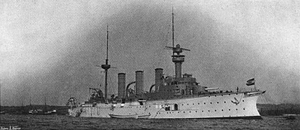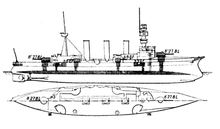SMS Vineta (1897)
 Vineta in 1902 | |
| History | |
|---|---|
| Name: | Vineta |
| Namesake: | Vineta |
| Builder: | Kaiserliche Werft, Danzig |
| Laid down: | 1895 |
| Launched: | 9 December 1897 |
| Commissioned: | 13 September 1899 |
| Struck: | 6 December 1919 |
| Fate: | Scrapped in 1920 |
| General characteristics | |
| Class and type: | Victoria Louise-class protected cruiser |
| Displacement: | Full load: 6,491 t (6,388 long tons) |
| Length: | 110.60 m (362 ft 10 in) |
| Beam: | 17.40 m (57 ft 1 in) |
| Draft: | 6.58 m (21 ft 7 in) |
| Propulsion: |
|
| Speed: | 19.6 knots (36 km/h; 23 mph) |
| Range: | 3,412 nmi (6,319 km; 3,926 mi) at 12 knots (22 km/h; 14 mph) |
| Complement: |
|
| Armament: |
|
SMS Vineta was a protected cruiser of the Victoria Louise class, built for the German Imperial Navy (Kaiserliche Marine) in the 1890s. Vineta was laid down at the AG Vulcan shipyard in 1895, launched in April 1897, and commissioned into the Navy in July 1898. The ship, named for the semi-legendary medieval town of Vineta, was armed with a battery of two 21 cm guns and eight 15 cm guns and had a top speed of 19 knots (35 km/h; 22 mph).
Vineta served abroad in the American Station for the first several years of her career. While on station in the Americas, she participated in the Venezuela Crisis of 1902–1903 and bombarded several Venezuelan fortresses. She returned to Germany in 1905 and was used as a torpedo training ship in 1908. She was modernized in 1909–1911, after which she was used as a school ship for naval cadets. In November 1912, she participated in an international naval protest of the First Balkan War. At the outbreak of World War I, Vineta was mobilized into the 5th Scouting Group, but served in front-line duty only briefly. She was used as a barracks ship after 1915, and ultimately sold for scrapping in 1920.
Design

Vineta was ordered under the contract name "M" and was laid down at the Imperial Dockyard in Danzig in 1896.[1] She was launched on 9 December 1897, after which fitting-out work commenced. She was commissioned into the German navy on 13 September 1899.[2] The ship was 110.60 meters (362 ft 10 in) long overall and had a beam of 17.40 m (57 ft 1 in) and a draft of 6.58 m (21 ft 7 in) forward. She displaced 6,491 t (6,388 long tons) at full combat load. Her propulsion system consisted of three vertical 4-cylinder triple expansion engines powered by twelve coal-fired Belleville boilers. Her engines provided a top speed of 19 knots (35 km/h; 22 mph) and a range of approximately 3,412 nautical miles (6,319 km; 3,926 mi) at 12 knots (22 km/h; 14 mph). She had a crew of 31 officers and 446 enlisted men.[3]
The ship was armed with two 21 cm SK L/40 guns in single turrets, one forward and one aft. The guns were supplied with 58 rounds of ammunition each. They had a range of 16,300 m (53,500 ft). Vineta also carried eight 15 cm SK L/40 guns. Four were mounted in turrets amidships and the other four were placed in casemates. These guns had a range of 13,700 m (44,900 ft). She also carried ten 8.8 cm SK L/35 naval guns.[1] The gun armament was rounded out by machine guns.[4] She was also equipped with three 45 cm (18 in) torpedo tubes with eight torpedoes, two launchers were mounted on the broadside and the third was in the bow, all below the waterline.[1]
Service history
Following her commissioning in 1899, Vineta was sent overseas.[2] Her commander was Kapitän zur See (Captain at Sea) Da Fonseca-Wollheim.[5] The ship was assigned to the American Station, along with the small cruiser Geier and the gunboat Luchs.[6] In May 1900, Vineta inspected Margarita Island for its potential as a naval base, but the Germans determined the port was insufficient for their purposes.[7] In late 1901, Vineta and the small cruiser Falke were sent to Venezuela in a show of force to compel the Venezuelan government to make reparations for grievances related to internal conflicts in the 1890s.[8] Starting in December 1902, Vineta participated in the German naval contingent in the Venezuela Crisis of 1902–1903. A British merchant ship had been boarded and its crew arrested by Venezuelan forces on 13 December; in response, British forces bombarded the forts at Puerto Cabello, and enlisted Vineta in the attack. Vineta was tasked with shelling the fortresses Libertador and Vigia.[9] In January 1903, the gunboat Panther attacked Fort San Carlos in Maracaibo, but was repulsed. Vineta therefore was sent to silence the guns on 21 January. During the bombardment of the fort, Vineta set it afire and destroyed the fortress.[10]
In 1903, one of Vineta's 15 cm ammunition magazines exploded, but did not cause major damage to the ship. The accident had significant long-term consequences, however, as it exposed the volatility of German propellant charges. The Germans therefore reworked the composition of the propellant, which was in service by 1914.[11] This new, more stable propellant saved several German battlecruisers from destruction when their magazines were penetrated by British shells during World War I.[12] In January 1904, the ship visited New Orleans with the rest of the American Squadron, which at that time included Falke, Panther, and Gazelle.[13] Vineta was detached from the American Squadron and returned to Germany in 1905.[2] She was used as a torpedo training ship starting in 1908. In 1909, she went to dry dock at the Imperial Dockyard in Danzig for a refit, during which she was re-boilered. Vineta originally had three stacks, and during the modernization they were trunked into two funnels. The refit was finished by 1911, at which point Vineta became a cadet training ship.[3]
The ship cruised in the western Mediterranean in the autumn of 1912, along with her sister Hertha. The old cruiser Geier was also in the region.[14] As the Bulgarian army was poised to march on Constantinople during the First Balkan War, the Great Powers deployed a naval force to ensure the safety of foreign nationals in the Ottoman Empire. Vineta and the battlecruiser Goeben were sent to Constantinople as part of this force. The international fleet sent ashore a force of around 3,000 officers and men. The force was withdrawn to Crete after a ceasefire seemed imminent, but by February fighting again broke out, and the island was seized by Greece.[15] On 23 January 1914, Vineta was in Haiti, when Michel Oreste abdicated from the presidency. He sought refuge aboard the ship, which landed marines along with the American cruiser USS Montana in Port-au-Prince to prevent rioting in the capital.[16]
Vineta had a short career during World War I. At the outbreak of hostilities, she was briefly mobilized into the 5th Scouting Group, which was tasked with training cadets in the Baltic Sea. By the end of 1914, however, the ships were again removed from service.[17] She was then put into service as a coastal defense ship. After 1915, she was withdrawn from front-line duty again and employed as a barracks ship at the Imperial Dockyard in Kiel. She was stricken from the naval register on 6 December 1919 and sold to ship-breakers in Harburg. She was scrapped the following year.[2]
See also
- Vineta provisional, a famous stamp issued on SMS Vineta in 1901.
Notes
- 1 2 3 Gröner, p. 47
- 1 2 3 4 Gröner, p. 48
- 1 2 Gröner, pp. 47–48
- ↑ Gardiner, p. 254
- ↑ Naval Notes, p. 691
- ↑ Naval Notes, p. 693
- ↑ Mitchell, p. 67
- ↑ Forbes, p. 325
- ↑ Mitchell, p. 86
- ↑ The New York Times, 23 January 1903, GERMAN COMMANDER BLAMES VENEZUELANS; Commodore Scheder Says That Fort San Carlos Fired First.
- ↑ Campbell, pp. 369–370
- ↑ Campbell, 373–374
- ↑ Witte, pp. 230–231
- ↑ Vego, p. 124
- ↑ Willmott, p. 181
- ↑ Colby, p. 332
- ↑ Gardiner & Gray, p. 142
References
- Colby, Frank Moore, ed. (1915). The New International Year Book. New York, NY: Dodd, Mead & Company.
- Campbell, John (1998). Jutland: An Analysis of the Fighting. London: Conway Maritime Press. ISBN 1-55821-759-2.
- Forbes, Ian L. D. (1978). "The German Participation in the Allied Coercion of Venezuela 1902–1903". Australian Journal of Politics & History. Royal United Services Institute for Defence Studies. 24 (3): 317–331. doi:10.1111/j.1467-8497.1978.tb00261.x.
- Gardiner, Robert, ed. (1979). Conway's All the World's Fighting Ships 1860–1905. Greenwich: Conway Maritime Press. ISBN 0-8317-0302-4.
- Gardiner, Robert; Gray, Randal, eds. (1984). Conway's All the World's Fighting Ships: 1906–1922. Annapolis: Naval Institute Press. ISBN 0-87021-907-3.
- Gröner, Erich (1990). German Warships 1815–1945. Annapolis, MD: Naval Institute Press. ISBN 0-87021-790-9.
- Mitchell, Nancy (1999). The Danger of Dreams: German and American Imperialism in Latin America. Chapel Hill, NC: University of North Carolina Press. ISBN 0807847755.
- "Naval Notes". R.U.S.I. Journal. London: Royal United Services Institute for Defence Studies. XLIV: 684–699. 1900. doi:10.1080/03071840009420016.
- Vego, Milan N. (1996). Austro-Hungarian Naval Policy, 1904–14. London: Frank Cass Publishers. ISBN 9780714642093.
- Willmott, H. P. (2009). The Last Century of Sea Power (Volume 1, From Port Arthur to Chanak, 1894–1922). Bloomington, IN: Indiana University Press. ISBN 978-0-253-35214-9.
- Witte, Emil (1916). Revelations of a German Attaché: Ten Years of German-American Diplomacy. New York, NY: George H. Doran Company.